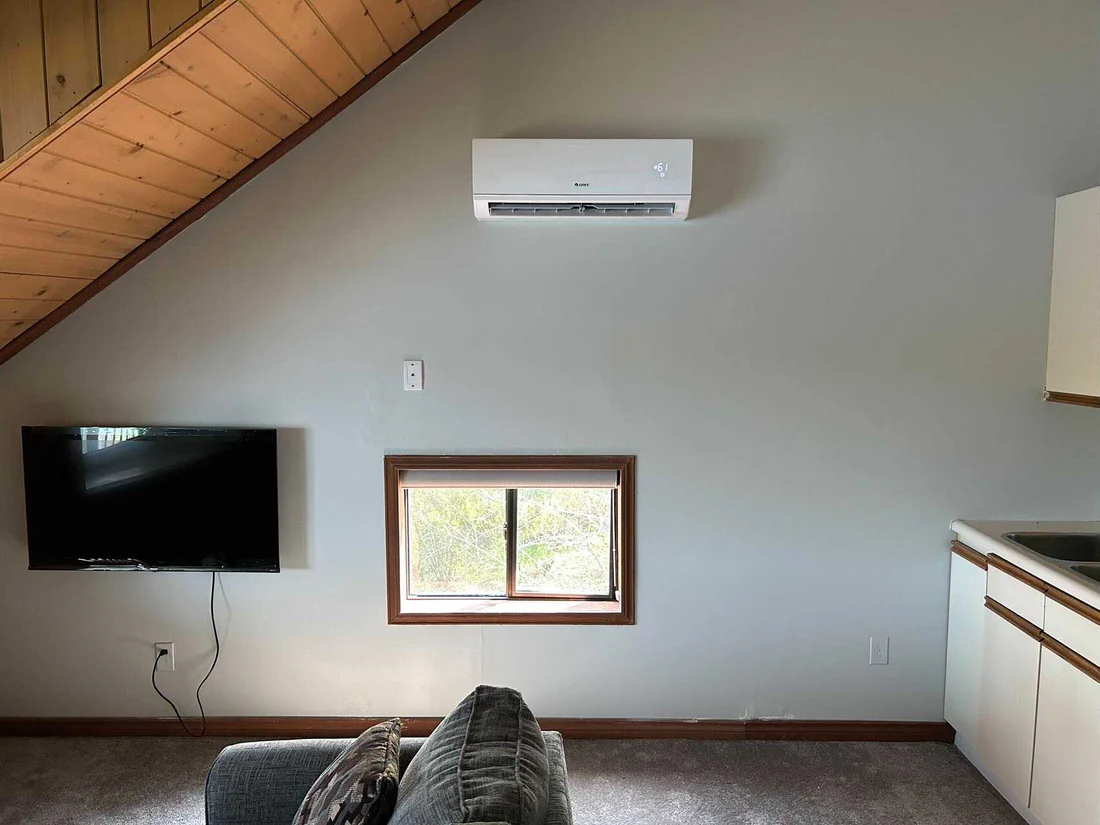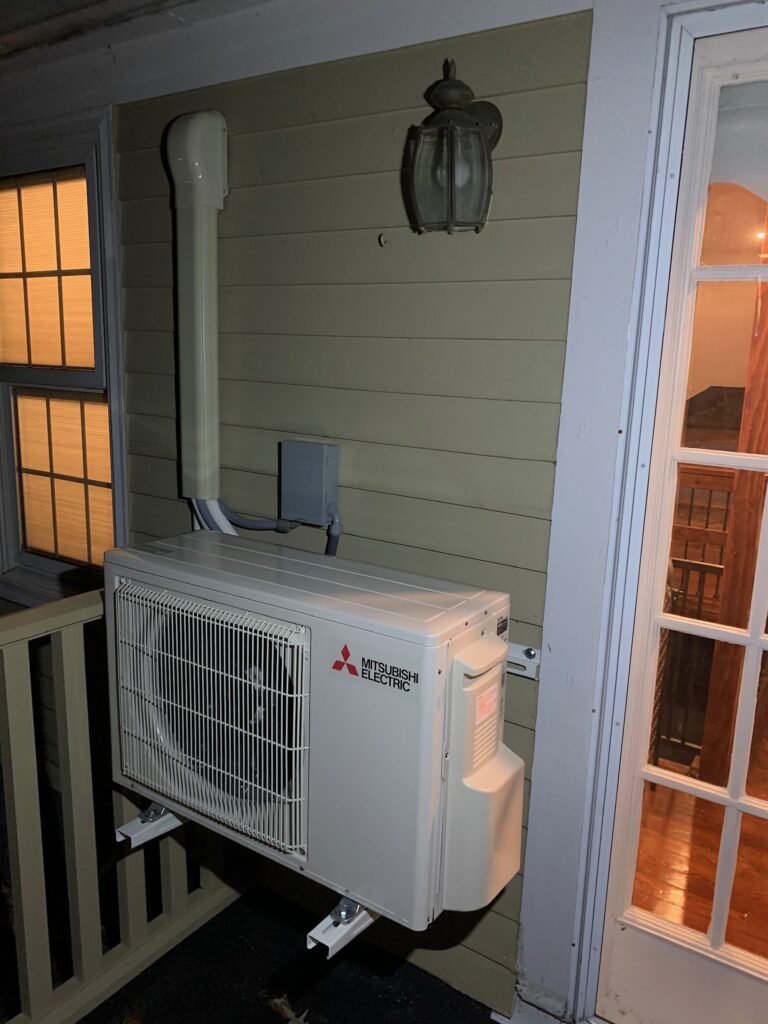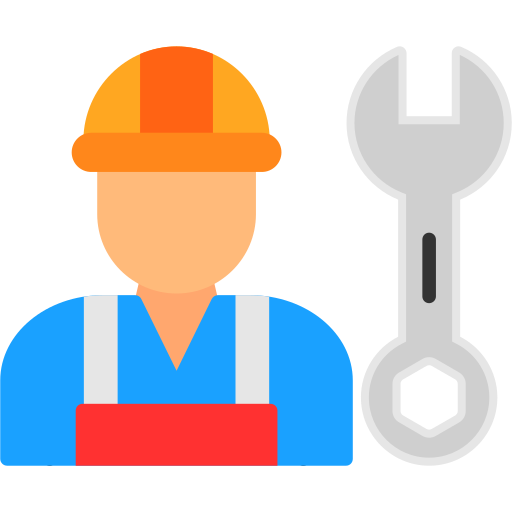Kirkland Ductless Mini-Split Installation and Repair Company
Installing Ductless Mini-Split Systems in Kirkland
- Older Homes Without Existing Ductwork: Provides a cost-effective way to add air conditioning and heating without the expense and disruption of installing ductwork.
- Room Additions and Renovations: Ideal for conditioning new spaces without having to extend your existing ductwork.
- Sunrooms, Garages, and Workshops: Provides comfortable temperatures in spaces that are often difficult to heat and cool.
- Bedrooms and Home Offices: Offers personalized temperature control for optimal comfort and productivity.
- Supplemental Heating or Cooling: Can be used to supplement your existing central air system in areas that are difficult to heat or cool.
- Whole-Home Heating and Cooling: In some cases, a multi-zone mini-split system can be used to condition your entire home.

Kirkland Ductless Mini-Split Installation Process
1.
Personalized Consultation
2.
Efficient Installation
3.
Thorough Testing
4.
System Walkthrough
5.
Ongoing Support
Benefits of Ductless Mini-Split Systems in Kirkland
- Energy Efficiency: Mini-splits are incredibly energy-efficient, using up to 60% less energy than traditional electric heating and cooling systems. This can lead to significant savings on your utility bills.
- Targeted Comfort: With individual thermostats for each indoor unit, you can customize the temperature in each room or zone, eliminating hot and cold spots and ensuring everyone’s comfort.
- Easy Installation: Since they don’t require ductwork, mini-splits are much easier and less disruptive to install than central air systems, making them ideal for older homes, additions, and renovations.
- Quiet Operation: Ductless systems operate very quietly, both indoors and outdoors, providing a peaceful environment.
- Improved Indoor Air Quality: Many mini-split systems come with advanced air filtration features that can help remove dust, allergens, and other pollutants from the air.
- Versatile Applications: Mini-splits can be used for both heating and cooling, providing year-round comfort. They can be used to condition a single room, multiple rooms, or even your entire home.
- Environmentally Friendly: Ductless mini-splits use a refrigerant called R410A, which is considered to be more environmentally friendly than older refrigerants.
- Rebates and Incentives: Depending on your location and the system you choose, you may be eligible for rebates and tax incentives that can help offset the cost of installation.

Why Choose Kirkland Hvac for Your Mini-Split Installation?

Expertise and Experience

Top-Quality Products

Customized Solutions

Professional Installation

Exceptional Customer Service

Competitive Pricing and Financing
General Furnace Questions:
We recommend having your furnace professionally serviced at least once a year, ideally in the fall before the heating season begins. Regular maintenance helps ensure your furnace is operating safely and efficiently, and can help prevent unexpected breakdowns.
Some common signs that your furnace may need repair include:
- Insufficient heat or cold spots in your home
- Strange noises (banging, rattling, squealing) coming from the furnace
- The furnace frequently cycles on and off
- The pilot light keeps going out (for older furnaces)
- Your energy bills are unusually high
- The furnace isn’t turning on at all
- Yellow burner flame instead of blue
The average lifespan of a furnace is around 15-20 years, although this can vary depending on the brand, model, how well it’s maintained, and usage patterns. Regular maintenance can help extend the life of your furnace
A furnace tune-up is a preventative maintenance service performed by a qualified HVAC technician. It typically includes:
- Inspecting and cleaning the burner assembly
- Checking the heat exchanger for cracks or damage
- Inspecting and cleaning the blower motor
- Checking and replacing air filters
- Testing the thermostat and controls
- Lubricating moving parts
- Checking for gas leaks (for gas furnaces)
- Inspecting electrical connections
The type of filter you need depends on your specific furnace model and your indoor air quality needs. Generally, a higher MERV (Minimum Efficiency Reporting Value) rating indicates a more effective filter at trapping smaller particles. We can help you choose the right filter for your system during a maintenance visit or consultation.
The type of filter you need depends on your specific furnace model and your indoor air quality needs. Generally, a higher MERV (Minimum Efficiency Reporting Value) rating indicates a more effective filter at trapping smaller particles. We can help you choose the right filter for your system during a maintenance visit or consultation.
Furnace Repair FAQs:
First, check your thermostat to make sure it’s set to “heat” and the temperature is set higher than the current room temperature. Next, check your circuit breaker to see if a breaker has tripped. If these steps don’t resolve the issue, it’s time to call a qualified HVAC technician for a diagnosis.
Different noises can indicate different problems. For example, a banging noise could indicate a problem with the ignition, while a rattling noise might suggest a loose panel or component. It’s best to have a technician diagnose the cause of the noise to ensure the proper repair is made.
The cost of furnace repair can vary widely depending on the nature of the problem, the parts needed, and labor costs. We provide upfront pricing after diagnosing the issue, so you’ll know the cost before we begin any work.
Furnace Installation FAQs:
Consider replacing your furnace if:
- It’s more than 15-20 years old
- It requires frequent repairs
- Your energy bills are consistently high
- It’s not heating your home adequately
- You’re looking to upgrade to a more energy-efficient model
Furnace size is measured in BTUs (British Thermal Units). The correct size depends on factors like your home’s square footage, insulation, climate, and window efficiency. We perform a thorough load calculation to determine the appropriate furnace size for your home to ensure optimal performance and efficiency.
Our installation process typically includes:
- A free consultation to assess your needs and recommend the best furnace
- Removal of your old furnace
- Installation of the new furnace, including all necessary connections and ductwork modifications
- System testing and calibration
- A walkthrough of the new system’s operation and features
Single-stage furnaces have only one heat output level (high) and cycle on and off more frequently. Two-stage furnaces have two heat output levels (high and low) and operate more efficiently, providing more consistent temperatures. Modulating furnaces can adjust their heat output continuously, offering the most precise temperature control and highest energy efficiency.
Furnace Maintenance FAQs:
The most important thing you can do is regularly check and change your furnace filter (usually every 1-3 months, depending on the filter type and your home’s air quality). You can also keep the area around your furnace clean and free of debris. However, for safety and optimal performance, it’s essential to have a professional technician perform annual maintenance.
Annual maintenance helps prevent breakdowns, improves energy efficiency, extends the lifespan of your furnace, ensures safe operation, and maintains your manufacturer’s warranty.
Yes, we offer preventative maintenance plans that can save you money on annual tune-ups and provide priority service. Contact us to learn more about our maintenance plan options.
Safety FAQs:
Carbon monoxide is a colorless, odorless gas that can be deadly. Signs of a leak can include:
- Headaches
- Dizziness
- Nausea
- Fatigue
- Confusion
- Flu-like symptoms that improve when you leave your home
- A yellow or wavering burner flame (instead of a crisp blue flame)
- Soot or black residue around your furnace
- The smell of rotten eggs in your home.
If you suspect a carbon monoxide leak, immediately open windows, leave your home, and call your gas company or 911. Install carbon monoxide detectors on every level of your home and test them regularly.
If you smell gas, do not try to locate the source yourself. Do not light matches, turn on or off any electrical switches, or use your phone inside your home. Immediately leave your home and call your gas company or 911 from a safe location.